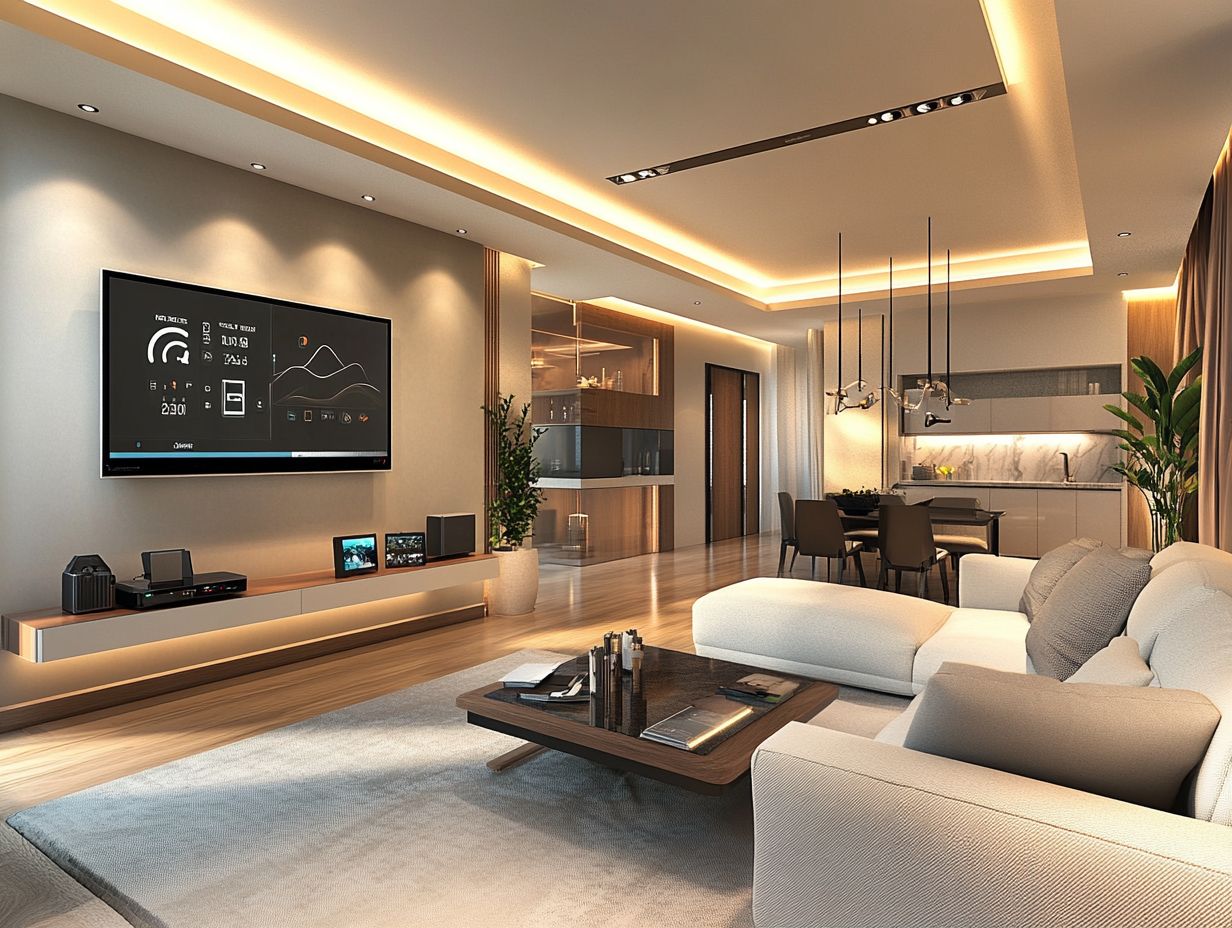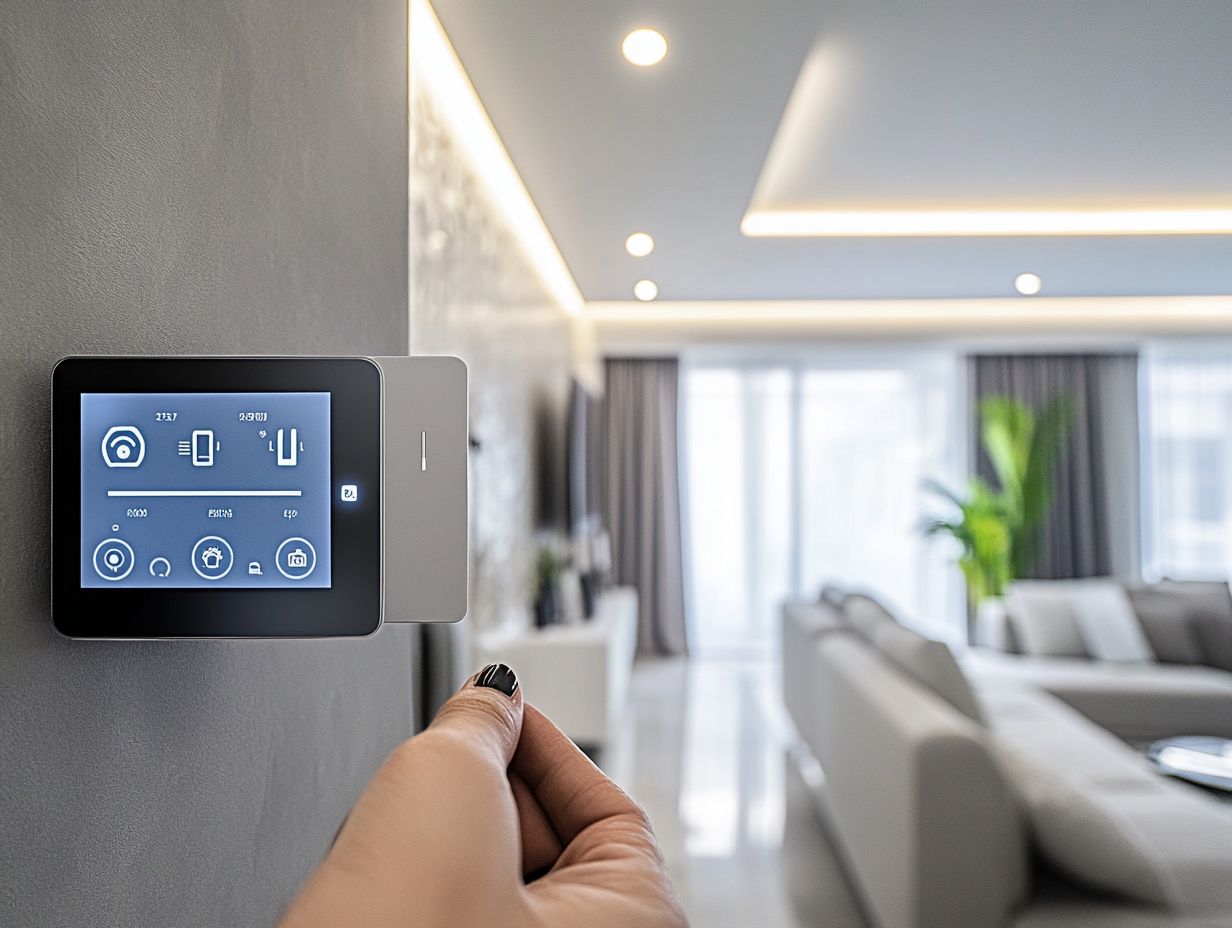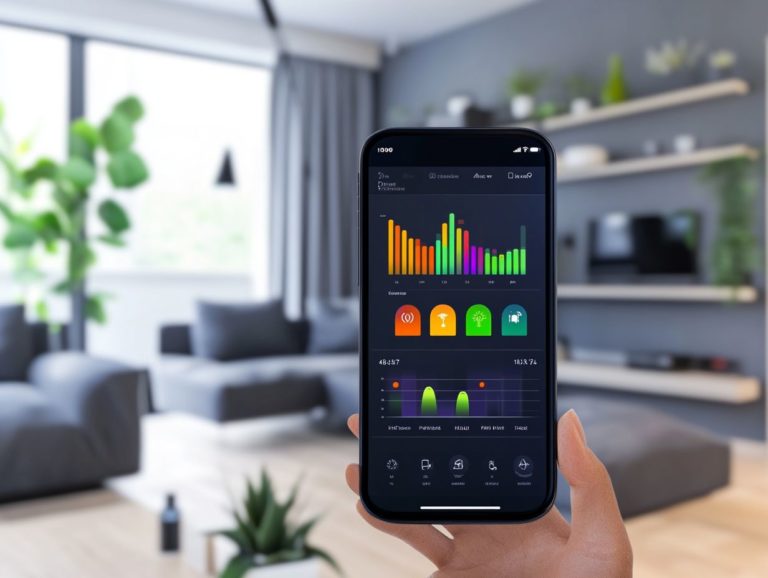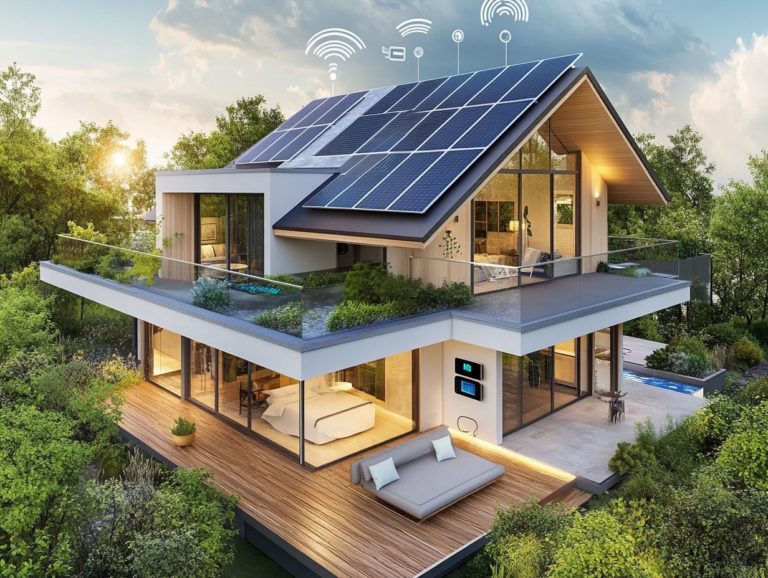How to Set Up a Smart Home Energy System
In today s fast-paced world, managing energy consumption is more crucial than ever. A Smart Home Energy System presents a modern solution, seamlessly integrating technology to boost efficiency and trim costs.
This article delves into the key benefits you can enjoy, from significant energy savings and unparalleled convenience to the essential components that comprise such a system.
You ll also uncover a step-by-step guide for setting one up, complete with tips to maximize your savings.
Jump in now to see how you can turn your home into an energizing haven!
Contents
- Key Takeaways:
- Benefits of a Smart Home Energy System
- Components of a Smart Home Energy System
- Setting Up a Smart Home Energy System
- Costs and Savings of a Smart Home Energy System
- Tips for Maximizing Energy Savings
- Frequently Asked Questions
- What is a smart home energy system and how does it work?
- What are the benefits of setting up a smart home energy system?
- What devices do I need to set up a smart home energy system?
- How do I choose the right smart home energy system for my home?
- Do I need to be tech-savvy to set up a smart home energy system?
- Can I save money on my energy bills by using a smart home energy system?
Key Takeaways:

- Save money and energy with a smart home energy system through increased efficiency and control.
- Components like smart thermostats, lighting, and plugs make up a smart home energy system, offering convenience and energy savings.
- Maximize savings by following best practices for using and setting up a smart home energy system, and consider the initial investment for long-term savings.
What is a Smart Home Energy System?
A Smart Home Energy System seamlessly integrates smart devices and tools that help save energy, elevating the efficiency and functionality of your household.
These systems typically feature components like smart thermostats, energy monitors, and automated lighting. All work together harmoniously to optimize resource use. For example, a smart thermostat can learn your schedule, adjusting heating and cooling accordingly to minimize energy waste.
Energy monitors deliver real-time data, enabling you to detect inefficiencies and discern patterns in your energy usage.
Sync with devices now to take control of your energy and start saving! By using platforms like Google Home or Apple HomeKit, you can effortlessly control and schedule your energy consumption, ensuring that appliances run during off-peak hours. This level of interaction leads to substantial cost savings and a smaller carbon footprint.
Benefits of a Smart Home Energy System
The benefits of a Smart Home Energy System are truly remarkable. They offer you energy savings, enhanced convenience, and an improved user experience.
These systems enable you with intelligent automation for various appliances. They optimize your energy consumption and provide you with valuable insights into your home ecosystem.
Embracing this technology not only simplifies your life but also elevates your living environment to new heights of efficiency and comfort.
Energy Savings and Efficiency
Energy savings and efficiency lie at the heart of smart home energy systems. They harness advanced technologies to track and optimize your energy consumption in real-time.
By implementing smart sensors and energy metering, you can easily monitor your energy usage patterns. This enables you to make informed decisions that reduce waste and lower your utility bills.
Integrating smart plugs into your home setup provides a seamless way to manage energy-hungry appliances. They ensure that appliances operate only when you need them and can automatically turn off devices that consume unnecessary energy during idle times.
With user-friendly apps, you can set up automation routines, allowing you to schedule your electrical devices to run during off-peak hours, taking advantage of lower energy rates.
Ultimately, these innovations enable you to create a proactive energy management strategy, significantly enhancing your overall efficiency and sustainability.
Convenience and Control
Smart home energy systems transform your home into a personal paradise! Enjoy convenience and control as you effortlessly manage your environment using smart devices and voice commands. Whether you prefer Google Assistant, Amazon Alexa, or Apple HomeKit, easily access features like remote monitoring and adjust energy settings from virtually anywhere. Significantly enhance your overall experience.
Integrating various smart devices, such as smart thermostats and lighting, creates a seamless connection that boosts efficiency. Custom automation routines let you craft schedules that fit your lifestyle perfectly. For instance, dimming the lights when it s movie time or adjusting the thermostat at night ensures ideal comfort.
With app control at your fingertips, managing your home becomes a breeze. Monitor energy consumption in real-time and receive alerts about any unusual activity. Control your appliances remotely to ensure a truly interconnected home experience.
Components of a Smart Home Energy System

The components of a Smart Home Energy System are essential for its overall functionality and effectiveness. This includes an array of devices such as smart thermostats, smart lighting systems, smart plugs, and smart displays.
These elements collaborate seamlessly within a cohesive system. This enables device automation and energy management tailored to meet your household’s unique needs.
Smart Thermostats
Smart thermostats are essential elements of a Smart Home Energy System, designed to optimize your heating and cooling according to your preferences. These user-programmable devices learn your habits over time and can be easily controlled through mobile apps or voice commands. This helps you effectively reduce energy consumption.
These devices also offer real-time data insights. You can track your energy usage patterns and make informed decisions. Brands like Nest integrate effortlessly into your existing smart home ecosystem, enhancing the overall automation experience.
Imagine having the power to monitor and adjust your settings remotely, ensuring that your home remains comfortable and efficient whether you re there or away. Features like geofencing adjust your home’s temperature based on your location. Smart thermostats foster a more energy-efficient lifestyle while adapting seamlessly to the rhythm of your daily life.
Smart Lighting
Smart lighting systems elevate your home experience. They give you the ability to control lighting through smart bulbs like Philips Hue and integrate them into your automation routines. This helps you reduce energy consumption and allows you to personalize your lighting settings based on the time of day or your presence in the room.
Additionally, you can explore smart strips and smart panels, which offer versatile lighting solutions for various spaces in your home. These devices connect effortlessly with platforms such as Amazon Alexa or Google Assistant, enabling you to control your lights with just your voice. Create customizable scenes that match your mood.
Many smart lighting systems come packed with features like dimming, color changes, and scheduling. They adapt effortlessly to your lifestyle. By incorporating motion sensors, these systems enhance convenience while significantly cutting down on energy waste. Lights are only on when necessary!
With smart lighting, you gain not just efficiency but also a touch of modern luxury that transforms your living environment. Explore these smart home solutions and take control of your energy use today!
Smart Plugs and Power Strips
Smart plugs and power strips are essential for managing energy consumption in your smart home. They enable you to monitor and control your appliances from anywhere, giving you complete oversight over unnecessary energy use. By incorporating these devices into your setup, you can easily implement energy monitoring for your appliances.
These ingenious gadgets connect seamlessly to your existing Wi-Fi network. You can operate them from your smartphone or tablet no matter where you are! Imagine controlling your devices with just your voice smart plugs can be paired effortlessly with virtual assistants like Amazon Alexa or Google Assistant.
Power strips let you control multiple devices at once, whether it s lamps or televisions. Beyond just convenience, these tools also drive energy efficiency. You can schedule your appliances to run only when needed, leading to lower electricity bills while helping you reduce your carbon footprint.
Setting Up a Smart Home Energy System
Establishing a Smart Home Energy System requires a thoughtful and methodical approach to integrating smart devices and energy management tools. This ensures smooth communication and optimal functionality throughout your home.
By following a step-by-step guide, you can craft an efficient and interconnected living space perfectly tailored to your unique needs.
Step-by-Step Guide

Your journey to establishing a Smart Home Energy System begins with a thorough assessment of your current energy needs. Select compatible smart devices that facilitate effective energy management. This thoughtful process ensures optimal integration of devices, elevating your overall experience.
Next, explore the array of smart technologies available on the market, including smart thermostats, energy-efficient appliances, and home automation hubs that streamline your operations. For insights into the future of home energy management with smart tech, devices compatible with Google Assistant and Amazon Alexa offer additional voice command functionality.
Once you ve chosen the right devices, configure communication protocols such as Wi-Fi for general connectivity or ZigBee for a reliable way for smart devices to communicate with each other. Both options allow seamless interaction among your devices while prioritizing energy efficiency.
To sidestep common pitfalls, check compatibility features, ensure that devices are within range, and keep firmware updated. It’s also wise to verify device compatibility with your chosen smart home ecosystem. For those looking to enhance their home setup, learning how to upgrade your home for energy efficiency can provide valuable insights. Addressing these details upfront can significantly reduce potential issues down the road, paving the way for a smoother smart energy management experience.
Costs and Savings of a Smart Home Energy System
Grasping the costs and savings linked to a Smart Home Energy System is crucial for anyone contemplating this investment. Smart home setups can vary significantly in initial costs. While the initial price tag might appear substantial, the long-term savings can make it worthwhile, especially through energy monitoring and precise control over energy use!
As you reduce energy consumption and improve efficiency, you re likely to see a solid return on your investment over time. Start saving on your electricity bill today with smart devices!
Initial Investment and Long-Term Savings
When you consider a Smart Home Energy System, the initial investment includes the cost of smart devices, installation, and any necessary upgrades to your existing infrastructure.
However, smart home systems can save you money! The long-term savings from optimized energy management can far exceed those upfront costs, especially if you utilize device automation and set up automation routines to reduce energy costs with smart tech.
Investing in smart technologies, such as energy-efficient thermostats and automated lighting systems, can range from a few hundred to several thousand dollars. This depends on how extensively you implement them, including smart plugs for better control over your household appliances. For those considering upgrades, learning how to plan an energy-efficient home renovation can provide valuable insights.
Case studies suggest that homeowners can save up to 30% on their energy bills annually post-installation. A recent survey revealed that families who transitioned to smart home systems enjoyed an average savings of $500 per year due to reduced energy consumption.
Over the years, these savings can easily offset the initial expenditure, making such systems not just an eco-friendly choice, but also a financially smart decision.
Tips for Maximizing Energy Savings
Use targeted strategies to save energy and boost efficiency in your Smart Home Energy System. Harness the power of advanced smart devices and automation to refine your energy usage.
Best Practices for Using a Smart Home Energy System
Adopting best practices can significantly elevate your energy savings. Start by using smart sensors for precise monitoring and regularly checking your energy consumption data.
Integrate smart sensors that track temperature, occupancy, and appliance energy use for real-time insights. This data enables proactive adjustments, like dimming lights when a room is unoccupied.
Streamline your energy management by scheduling device operations during off-peak hours. For instance, running your dishwasher or washing machine at night can lead to substantial savings.
Energy monitoring tools provide valuable insights into your consumption habits. This helps you identify trends and pinpoint areas for improvement, guiding you toward a more energy-efficient home.
Frequently Asked Questions

What is a smart home energy system and how does it work?
A smart home energy system uses smart devices that work together to monitor and control energy usage in your home. This system allows for remote monitoring through a user-friendly app interface.
Devices include smart thermostats, smart light bulbs, smart power strips, and smart displays, enhancing your home automation experience. These devices communicate and can be controlled remotely through a smart hub or smartphone app, allowing seamless device integration.
What are the benefits of setting up a smart home energy system?
Enjoy lower energy bills and control your energy use anytime, anywhere! You ll gain increased energy efficiency and the convenience of managing your home’s energy usage through voice commands via smart speakers.
Smart home energy systems also provide valuable insights into your energy consumption patterns.
What devices do I need to set up a smart home energy system?
The specific devices you need depend on your individual needs and preferences. Common devices include smart thermostats, smart light bulbs, smart power strips, and energy monitoring systems compatible with the Matter standard.
How do I choose the right smart home energy system for my home?
When choosing a smart home energy system, first consider your energy habits. Think about the size of your home and your budget. Ensure the system supports both wired and wireless standards.
Research different brands and compare their features and compatibility with other devices, such as Philips Hue for smart lighting or Nest for thermostats. It may also be helpful to read reviews and ask for recommendations from friends or family who already have a smart home energy system. Learning about their experiences can provide valuable troubleshooting tips and insights on gateway management. Additionally, consider exploring how to make your home more energy efficient for further improvements.
Do I need to be tech-savvy to set up a smart home energy system?
No, you do not need to be tech-savvy to set up a smart home energy system. Many devices come with easy-to-follow instructions and can be set up using a smartphone app.
These apps often offer customizable settings that you can adjust for enhanced personalization. If you need assistance, you can also hire a professional to help with installation and setup.
Can I save money on my energy bills by using a smart home energy system?
Yes! A smart home energy system can help you save money on your energy bills. By monitoring and controlling your energy usage, you can identify areas where you may be using more energy than necessary and make adjustments accordingly.
While doing so, you can ensure high standards of data privacy by keeping your personal information safe. Some utility companies offer rebates or discounts if you use smart home energy systems.






